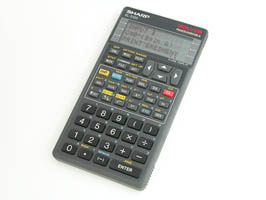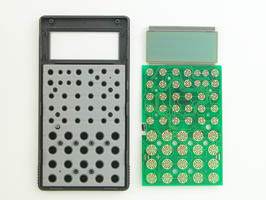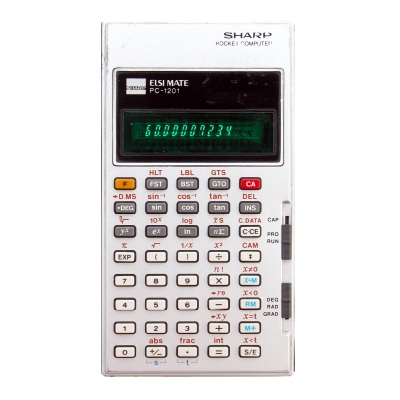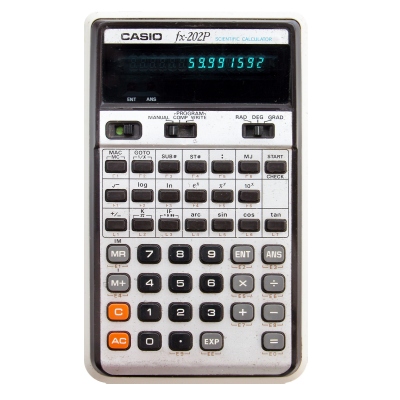Sharp EL-5120
| Manufacturer: | Sharp Corporation (Japan/China) |
| Mfg. date: | 1993-2000 |
| Size: | 7,6×14,4×1,1 cm |
| Weight (ready for operate): | 78 g |
| Type: | programmable scientific |
| Capacity: | 10+2 digits (input/display) 12+2 digits (internal precision) |
| Operating logic: | formula-interpreting |
| CPU: | Toshiba T6B86 |
| Registers: | 2 standard (with saving the pending operation) 16 bracket (with saving the pending operation) 36 memory (with aritmetic) |
| Features: | +/-change sign (direct entry of negative numbers) Ffloating-point notation Fixfixed-point notation: the listed decimals can be chosen (0-9) Sciscientific (exponential) notation Engengineering notation a b/callows entry and display of fractions BSbackspace (right-shift) function Sqrsquare root x2square pivalue of pi (3.1415..) can be recalled 1/xreciprocal trigtrigonometrical functions (sin, cos, tan and inverses: arcsin, arccos, arctan) hyphyperbolic functions (sinh, cosh, tanh and inverses: ar sinh, ar cosh, ar tanh) DMS-DDconversion of decimal and sexagesimal numbers logexponential and logarithmical functions (10- and e-base) yxraising to power SDone variable statistics: calculating mean and standard deviation LRtwo-variable statistics: linear regression nCrprobability calculations P-Rconverting coordinates between rectangular and polar systems n!factorial |
| Display: | dot-matrix LCD |
| Power: | 1×CR2025 battery |
| Programming method: | BASIC |
| Program capacity: | 1211 bytes |
| Test results: | trigonometry:result of sin-1(cos-1(tan-1(tan(cos(sin(60°)))))), reference value: 60. 60.00000067 exponential:result of 0.999160000, reference value (first 14 digits): 3.0068804206375×10-70 3.00688090276E-70 |
Programming the EL-5120
The less frequently used functions of the EL-5120, the settings of the calculation and display modes, the statistical functions and the special instructions for writing programs are arranged in menus, which can be accessed with the corresponding menu keys (MATH, 2ndF SET UP, 2ndF STAT, COMMAND). The menus can have several pages, in which case down or up arrows appear on the right side of the display. You can scroll through the pages with the ↑ and ↓ keys. Each menu item can be executed by pressing the corresponding number key. You can exit the menu with the QUIT key.The machine's programming model is related to the symbolic language of similar types, but for the sake of easier readability and simple programming, some symbols have been replaced with their BASIC equivalents.
The EL-5120 can operate in three modes for direct calculations: the REAL mode uses decimal numbers, standard scientific and statistical functions; the NBASE mode can solve calculations in the four number systems (binary, octal, decimal and hexadecimal) and supports logical operations. In SOLVER mode, you can use the built-in expression evaluation, equation solving, or integral calculation programs.
You can enter programming mode by pressing MODE 4. In the menu that appears, select the NEW option to write a new program, the EDIT option to edit an existing program, the RUN option to run a program, or the DEL option to delete a program.
The machine has 27 memory registers, which can be accessed as global variables by entering their names (A..Z and θ). It is also possible to declare up to 9 local variables that exist only within the program. Their names consist of a letter and a number (e. g. R1).
When writing and modifying programs, the usual keys found on similar calculators can be used: the arrows can be used to move in the appropriate direction in the program; the DEL key deletes a character after the cursor, the BS key before the cursor (backspace); CL deletes the entire line, 2ndF CA deletes the entire program; ENTER inserts a new line; 2ndF INS toggles between insert and overwrite modes.
When writing a new program, you must first specify the appropriate mode (REAL or NBASE), which determines the available mathematical instructions. Then you have to enter the name of the program.
When writing or modifying a program, the changes made in the given line can be finalized with the ↑, ↓ and ENTER keys, or canceled with the QUIT key.
Each line in the program can contain only one instruction, followed by ENTER. The one exception is the IF statement, which must be written on the samel line with the next GOTO instruction.
To run, edit or delete program, you need to select the appropriate program, which can be done in two ways after pressing the appropriate number key in the programming menu: by entering the two-digit program number, or from the list with the ↑ and ↓ keys and pressing ENTER.
The operations and functions used in the programs have the same syntax as in direct calculation, and functions not available on the keyboard can also be accessed from the MATH menu. The settings available from the SET UP menu cannot be written into a program, they can be set independently of the program.
To assign a value to a variable, use the equal sign, e.g. W=sin30. If there is no END statement at the end of the program, the assignment in the last line automatically displays the name and the value of the variable.
Programming instructions are available from the COMMAND menu, which can be accessed by pressing FILE:
- PRINT variable: displays the name and value of the given variable, e.g. PRINT W.
- PRINT"text: displays the given text. Any character can be used (numbers, letters and functions accessible from keyboard). E.g. PRINT"VALUE OF sin30.
- INPUT variable: displays the name of the given variable, and inputs a new value from the keyboard. E.g. INPUT W.
- WAIT number: waits for the given seconds, then continues running the program. If the number is omitted, waits for pressing any key. E.g. WAIT 3.
- REM text: remarks can be added to programs. E.g. REM AMORTIZATION.
- END: defines the end of the program. Can be omitted.
- LABEL label: defines the given label as a destination for the GOTO and GOSUB instructions. A maximum of 20 labels can be added to a program. The label can contains letters and numbers up to 7 characters. E.g. LABEL CALCULATION.
- CLRT: clears the display.
- IF condition GOTO label: if the given condition (which can be entered using relational operators from the COMMAND menu) is true, jumps to the given label. GOSUB instruction cannot be used in the IF statement. E.g. IF W<sin30 GOTO CALCULATION.
- GOTO label: Jumps to the given label. E.g. GOTO CALCULATION.
- GOSUB label: Jumps to the subroutine (subprogram) starting at the specified label. A maximum of 10 subroutines can be nested.
- RETURN: returns from the subroutine, and continues the program with the instruction next to the GOSUB instruction.
- relational operators: can be used to write condition for the IF statement. The equal sign can be entered with ALPHA =, too.
- DATA: (only in REAL mode) stores a new data (or pair of data) corresponding to the selected statistical mode. Weight can be used, separated by comma. E.g. DATA 3,2.
- STATx: (only in REAL mode) switches to one-variable statistical mode (standard deviation).
- STATxy: (only in REAL mode) switches to two-variable statistical mode (linear regression).
After writing or modifying the program, you can return to the programming menu by pressing the QUIT key. The program can be started using the RUN menu item. After selecting the appropriate program, the program starts. The running program can be interrupted at any time with the QUIT key. If an error is encountered, the program stops automatically, in which case the ← or → key will show the corresponding program line on the display.
The program memory has a capacity of 1211 bytes. Each local variable occupies 8 bytes. Local variables that have already been reserved cannot be deleted from the program. By default, the programs occupy 32 bytes each. Every program line occupies 3 bytes in addition to each keystroke (character) or instruction, which occupy 1 byte.







